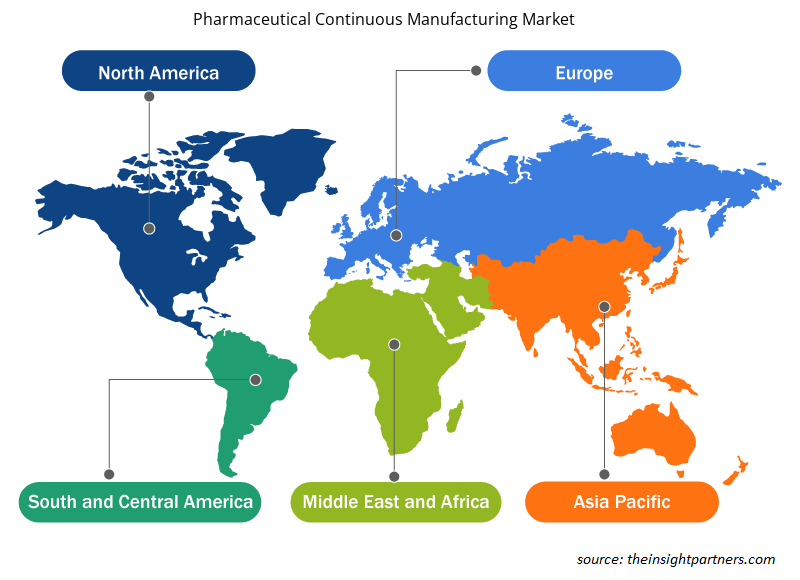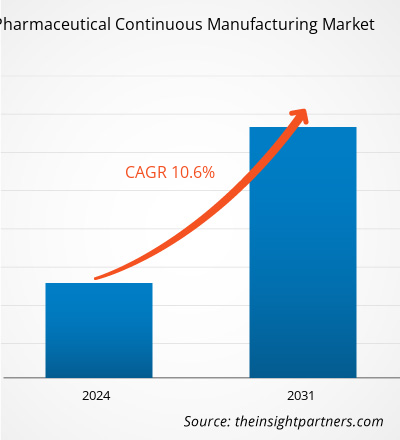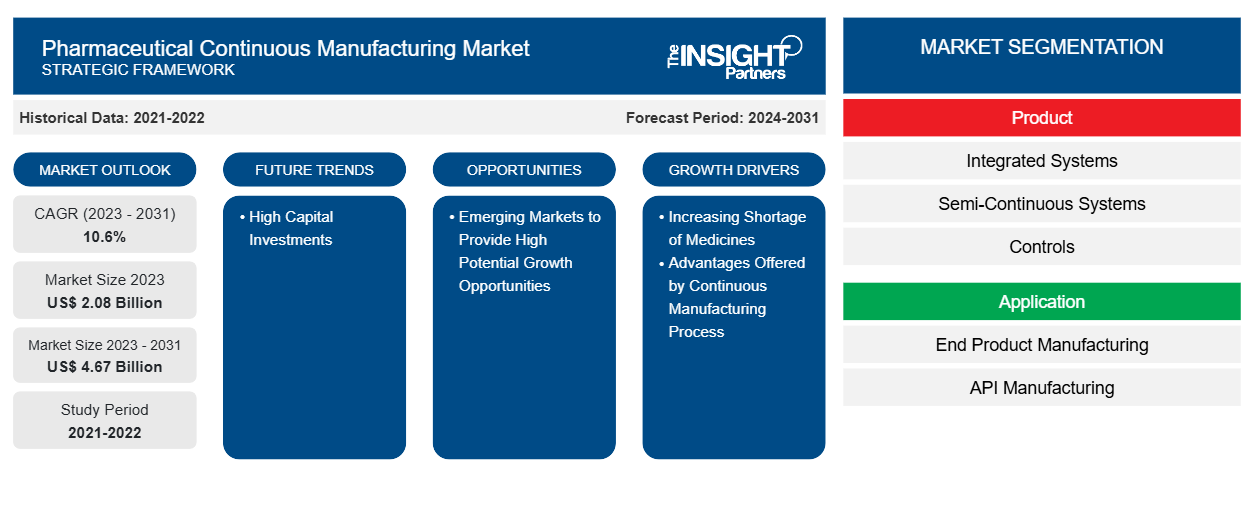Le marché de la fabrication continue de produits pharmaceutiques devrait atteindre 4,67 milliards USD d'ici 2031, contre 2,08 milliards USD en 2023. Le marché devrait enregistrer un TCAC de 10,6 % au cours de la période 2023-2031. Le soutien croissant des organismes de réglementation, l'adoption croissante par les fabricants sous contrat et internes des procédures de fabrication de médicaments et les avantages associés à la fabrication continue devraient rester les principales tendances du marché.
Analyse du marché de la fabrication pharmaceutique continue
Les entreprises pharmaceutiques investissent constamment dans des technologies de fabrication innovantes pour obtenir un avantage concurrentiel et rester en tête du marché, stimulant ainsi le marché de la fabrication continue. La fabrication continue permet aux entreprises pharmaceutiques d'avoir un meilleur contrôle sur leur processus de production, ce qui contribue à l'amélioration de la qualité et de la cohérence du produit final, réduisant ainsi les écarts, le gaspillage et économisant le temps de reprise et les coûts de rappel. La fabrication pharmaceutique continue peut améliorer la qualité du produit final, renforcer le contrôle des processus et permettre des tests de libération en temps réel. L'Agence européenne des médicaments ( EMA ) et la Food and Drug Administration (FDA) des États-Unis sont les organismes de réglementation qui favorisent de plus en plus l'utilisation de la fabrication continue dans l'industrie pharmaceutique. En outre, la fabrication continue est devenue plus attrayante et plus pratique dans l'industrie pharmaceutique en raison de la surveillance, du contrôle et de l'optimisation améliorés des processus fournis par les moyens d'automatisation, de contrôle des systèmes, d'analyse des données et de technologie d'analyse des processus (PAT), qui stimulent le marché.
Aperçu du marché de la fabrication pharmaceutique continue
La fabrication continue est une solution viable pour minimiser la pression et réduire le temps et les coûts de développement des médicaments, tout en maintenant la qualité et l'approvisionnement du produit final dans l'industrie pharmaceutique. Par conséquent, en raison de ces avantages, le marché de la fabrication continue connaît une croissance saine. En outre, les initiatives croissantes visant à promouvoir l'utilisation de systèmes de fabrication pharmaceutique continue par la Food and Drug Administration (FDA) et les nombreux avantages des systèmes de fabrication continue par rapport à la fabrication par lots sont quelques-uns des principaux facteurs qui stimulent la croissance du marché. Cependant, d'un autre côté, la mise en œuvre à coût élevé des systèmes de fabrication pharmaceutique continue est susceptible d'entraver la croissance du marché.
Personnalisez ce rapport en fonction de vos besoins
Vous bénéficierez d'une personnalisation gratuite de n'importe quel rapport, y compris de certaines parties de ce rapport, d'une analyse au niveau des pays, d'un pack de données Excel, ainsi que d'offres et de remises exceptionnelles pour les start-ups et les universités.
- Obtenez les principales tendances clés du marché de ce rapport.Cet échantillon GRATUIT comprendra une analyse de données, allant des tendances du marché aux estimations et prévisions.
Facteurs moteurs et opportunités du marché de la fabrication continue de produits pharmaceutiques
Avantages offerts par le processus de fabrication en continu pour favoriser le marché
La fabrication pharmaceutique continue est de plus en plus adoptée et prend de l'importance en raison de la demande croissante de produits biologiques et d'alternatives de fabrication flexibles. Les entreprises qui passent aux procédures de fabrication continue obtiennent rapidement l'approbation de la FDA. Le processus de fabrication continue offre de nombreux avantages, notamment une efficacité temporelle, une réduction des besoins énergétiques et du gaspillage, ainsi qu'une productivité accrue. En outre, le processus réduit le risque d'erreur humaine en raison de l'implication de quelques personnes dans le processus de fabrication. Par conséquent, en raison des avantages susmentionnés offerts par la fabrication continue, le marché devrait croître au cours des prochaines années.
Les marchés émergents offrent des opportunités de croissance à fort potentiel
Des sites d'externalisation attrayants pour les industries biopharmaceutiques émergent dans des régions telles que l'Asie-Pacifique et l'Asie du Sud et du Centre. La Chine et l'Inde offrent de faibles coûts de fabrication et d'exploitation qui sont des facteurs importants pour stimuler la croissance du marché dans la région Asie-Pacifique. La Chine et l'Inde indiquent toutes deux des perspectives d'avenir positives pour le marché en raison de la croissance récente de l' industrie biopharmaceutique dans les deux pays. En janvier 2020, STA Pharmaceutical Co., Ltd., une filiale de WuXi AppTec a ouvert une nouvelle usine de fabrication d'ingrédients pharmaceutiques actifs (API) oligonucléotidiques à grande échelle en Chine. Ainsi, les marchés émergents adaptés à l'industrie biopharmaceutique sont susceptibles d'agir comme des générateurs de croissance et de revenus à fort potentiel sur le marché de la fabrication pharmaceutique continue.
Analyse de segmentation du rapport sur le marché de la fabrication continue de produits pharmaceutiques
Les segments clés qui ont contribué à l’élaboration de l’analyse du marché de la fabrication continue de produits pharmaceutiques sont le produit, l’application et l’utilisateur final.
- En fonction du produit, le marché de la fabrication continue de produits pharmaceutiques est segmenté en systèmes intégrés, systèmes semi-continus et contrôles. Le segment des systèmes intégrés détenait la plus grande part de marché en 2023 et devrait enregistrer le TCAC le plus élevé au cours de la période de prévision.CAGR during the forecast period.
- En fonction des applications, le marché est divisé en fabrication de produits finis et fabrication d'API . Le segment de fabrication de produits finis est en outre divisé en fabrication de dosages solides et fabrication de dosages liquides. Le segment de fabrication de produits finis détenait la plus grande part du marché en 2023. Cependant, le segment de fabrication d'API devrait enregistrer le TCAC le plus élevé au cours de la période 2021-2031.
- En fonction de l'utilisateur final, le marché de la fabrication continue de produits pharmaceutiques est divisé en entreprises de fabrication à grande échelle et en départements de recherche et développement. Le segment de la fabrication à grande échelle détenait la plus grande part de marché en 2023 et devrait enregistrer le TCAC le plus élevé au cours de la période de prévision.
Analyse des parts de marché de la fabrication pharmaceutique continue par zone géographique
La portée géographique du rapport sur le marché de la fabrication continue de produits pharmaceutiques est principalement divisée en cinq régions : Amérique du Nord, Asie-Pacifique, Europe, Moyen-Orient et Afrique, et Amérique du Sud et centrale.
L'Amérique du Nord domine le marché de la fabrication pharmaceutique continue. Les facteurs qui ont conduit à la croissance du marché de la fabrication pharmaceutique continue en Amérique du Nord sont dus au soutien croissant de la FDA pour promouvoir l'utilisation de la fabrication continue par rapport à la fabrication par lots, à la pénurie croissante de médicaments dans la région et à la présence de géants pharmaceutiques qui peuvent se permettre les investissements initiaux importants pour mettre en place des processus de fabrication continue. La majorité des industries aux États-Unis ont adopté des processus de fabrication continue depuis des décennies. Les États-Unis occupent une position dominante en Amérique du Nord en raison de facteurs tels que le nombre croissant d'acteurs pharmaceutiques adoptant des procédures de fabrication continue, les progrès dans le domaine des technologies de fabrication et l'efficacité offerte par ces configurations pour augmenter les volumes de production. En outre, diverses initiatives ont été prises par la FDA américaine pour promouvoir la fabrication continue aux États-Unis au sein des industries pharmaceutiques.
Aperçu régional du marché de la fabrication continue de produits pharmaceutiques
Les tendances régionales et les facteurs influençant le marché de la fabrication continue de produits pharmaceutiques tout au long de la période de prévision ont été expliqués en détail par les analystes d’Insight Partners. Cette section traite également des segments et de la géographie du marché de la fabrication continue de produits pharmaceutiques en Amérique du Nord, en Europe, en Asie-Pacifique, au Moyen-Orient et en Afrique, ainsi qu’en Amérique du Sud et en Amérique centrale.

- Obtenez les données régionales spécifiques au marché de la fabrication continue de produits pharmaceutiques
Portée du rapport sur le marché de la fabrication pharmaceutique continue
| Attribut de rapport | Détails |
|---|---|
| Taille du marché en 2023 | 2,08 milliards de dollars américains |
| Taille du marché d'ici 2031 | 4,67 milliards de dollars américains |
| Taux de croissance annuel composé mondial (2023-2031) | 10,6% |
| Données historiques | 2021-2022 |
| Période de prévision | 2024-2031 |
| Segments couverts | Par produit
|
| Régions et pays couverts | Amérique du Nord
|
| Leaders du marché et profils d'entreprises clés |
|
Densité des acteurs du marché : comprendre son impact sur la dynamique des entreprises
Le marché de la fabrication continue de produits pharmaceutiques connaît une croissance rapide, tirée par la demande croissante des utilisateurs finaux en raison de facteurs tels que l'évolution des préférences des consommateurs, les avancées technologiques et une plus grande sensibilisation aux avantages du produit. À mesure que la demande augmente, les entreprises élargissent leurs offres, innovent pour répondre aux besoins des consommateurs et capitalisent sur les tendances émergentes, ce qui alimente davantage la croissance du marché.
La densité des acteurs du marché fait référence à la répartition des entreprises ou des sociétés opérant sur un marché ou un secteur particulier. Elle indique le nombre de concurrents (acteurs du marché) présents sur un marché donné par rapport à sa taille ou à sa valeur marchande totale.
Les principales entreprises opérant sur le marché de la fabrication continue de produits pharmaceutiques sont :
- Groupe GEA
- Coperion GmbH
- Gericke AG
- Glatt GmbH
- Groupe Hosokawa Micron
- Munson Machinery Co. Inc.
Avis de non-responsabilité : les sociétés répertoriées ci-dessus ne sont pas classées dans un ordre particulier.

- Obtenez un aperçu des principaux acteurs du marché de la fabrication pharmaceutique continue
Actualités et développements récents du marché de la fabrication continue de produits pharmaceutiques
Le marché de la fabrication continue de produits pharmaceutiques est évalué en collectant des données qualitatives et quantitatives après des recherches primaires et secondaires, qui comprennent des publications d'entreprise importantes, des données d'association et des bases de données. Quelques-uns des développements du marché de la fabrication continue de produits pharmaceutiques sont répertoriés ci-dessous :
- SK Bioscience, société de développement et de fabrication sous contrat (CDMO) basée en Corée du Sud, a lancé les travaux d'agrandissement d'environ 4 200 m2 de son usine de fabrication de vaccins L House à Andong, Gyeongsang du Nord, en Corée du Sud, qui servira de base de production pour le vaccin conjugué antipneumococcique GBP410, développé conjointement par SK Bioscience et Sanofi, qui co-investissent dans l'agrandissement. (SK Bioscience, communiqué de presse, mars 2024)
- Phlow Corp., une société américaine d'utilité publique spécialisée dans les médicaments essentiels, a annoncé des alliances stratégiques avec le Medicines for All Institute de la Virginia Commonwealth University (VCU) et AMPAC Fine Chemicals pour fournir des services contractuels de recherche et développement (R&D) en fabrication continue pour les produits pharmaceutiques à petites molécules. En plus de ses capacités internes robustes et croissantes, le réseau de partenaires stratégiques établis, innovants et expérimentés de Phlow fournira des solutions de fabrication avancées de haute qualité basées aux États-Unis pour les principes pharmaceutiques actifs (API) à petites molécules et les matières premières enregistrées (RSM) à tous les stades de développement en utilisant des technologies de pointe et des connaissances sectorielles uniques. (Phlow Corp., News, mars 2022)
Rapport sur le marché de la fabrication pharmaceutique continue et produits livrables
Le rapport « Taille et prévisions du marché de la fabrication continue de produits pharmaceutiques (2021-2031) » fournit une analyse détaillée du marché couvrant les domaines ci-dessous :
- Taille et prévisions du marché de la fabrication continue de produits pharmaceutiques aux niveaux mondial, régional et national pour tous les segments de marché clés couverts par le périmètre
- Tendances du marché de la fabrication pharmaceutique continue ainsi que la dynamique du marché telles que les moteurs, les contraintes et les opportunités clés
- Analyse PEST et SWOT détaillée
- Analyse du marché de la fabrication continue de produits pharmaceutiques couvrant les principales tendances du marché, le cadre mondial et régional, les principaux acteurs, les réglementations et les développements récents du marché
- Analyse du paysage industriel et de la concurrence couvrant la concentration du marché, l'analyse de la carte thermique, les principaux acteurs et les développements récents du marché de la fabrication continue de produits pharmaceutiques
- Profils d'entreprise détaillés
- Analyse historique (2 ans), année de base, prévision (7 ans) avec TCAC
- Analyse PEST et SWOT
- Taille du marché Valeur / Volume - Mondial, Régional, Pays
- Industrie et paysage concurrentiel
- Ensemble de données Excel
Rapports récents
Témoignages
Raison d'acheter
- Prise de décision éclairée
- Compréhension de la dynamique du marché
- Analyse concurrentielle
- Connaissances clients
- Prévisions de marché
- Atténuation des risques
- Planification stratégique
- Justification des investissements
- Identification des marchés émergents
- Amélioration des stratégies marketing
- Amélioration de l'efficacité opérationnelle
- Alignement sur les tendances réglementaires





















 Obtenez un échantillon gratuit pour - Marché de la fabrication pharmaceutique continue
Obtenez un échantillon gratuit pour - Marché de la fabrication pharmaceutique continue